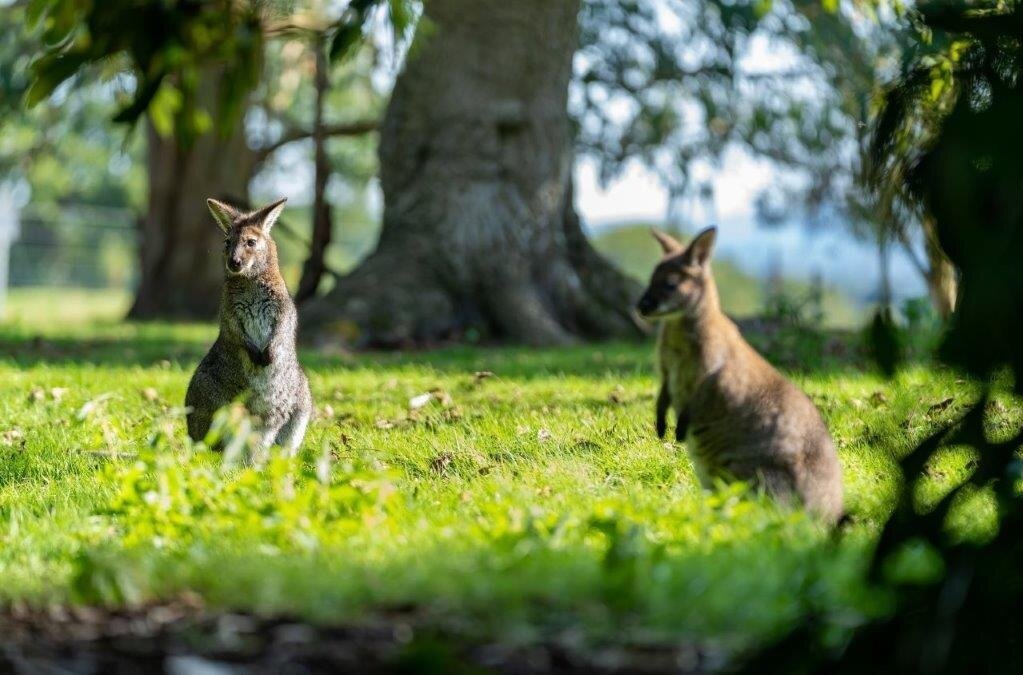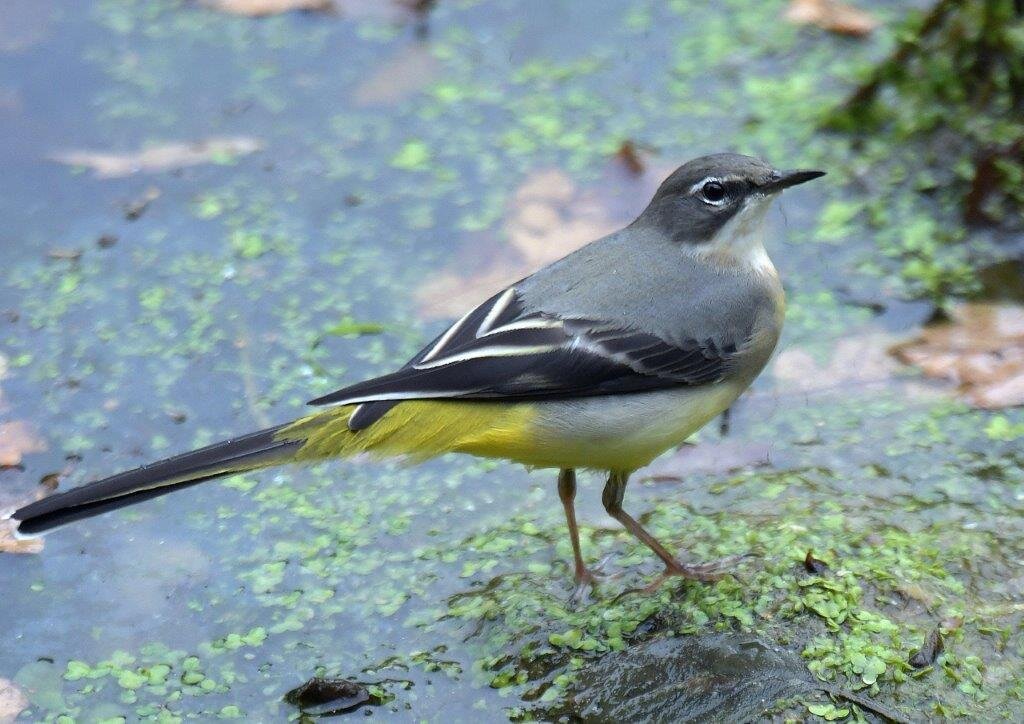WILDLIFE AT LEONARDSLEE
The estate known today was once part of St Leonards Forest which was thought to be part of the ancient forests of the High Weald. In the Middle Ages and by luck, the soil was too acidic (one of the reasons why rhododendrons, azaleas & camellias thrive in the gardens) for agriculture and thus remaind as a natural woodland with wild animals & deer for the chase.
Today, Leonardslee provides a peaceful and unspoiled environment where nature thrives.
The estate is home to an extraordinary range of wildlife including foxes, rabbits, grey squirrels, badgers, weasels, stoats, shrews, voles, and our now famous wallabies. Green woodpeckers are often spotted, while herons enjoy the shallow lakeside water where carp feed on the surface. Birds regularly sighted include the kingfisher, wild mandarin ducks, nuthatches, and treecreepers. Leonardslee has an extensive deer park which is home to over 100 free-roaming deer; with varieties: Sika and Fallow.

LEONARDSLEE WALLABIES
The Leonardslee wallabies were introduced by naturalist Sir Edmund Loder in 1889, and are believed to be Bennett’s Wallabies from Tasmania, Australia. They are winter-hardy, with a thick coat perfect for keeping them warm during the cold English winter.
Bennett’s wallabies, also called red-necked wallabies, are members of the macropod family, which also includes kangaroos & wallaroos.
Our free-roaming wallabies have an acute sense of smell and hearing. Their large ears are capable of moving 180’ independently, which allow them to remain alert for potential predators, such as foxes.
JOEYS & MATERNITY ENCLOSURE
Breeding season is in January and February, and gestation lasts for just 29 days! Bennett’s wallabies are born weighing less than 1 gram and climb into their mothers’ pouch where they continue to develop. Joeys stay in the warm, safe environment of their mothers’ pouch for about nine months and remain with their mothers, continuing to nurture for an additional three - nine months.
Females reach maturity around 14 months & males around 19 months.
You can visit the wallaby enclosure which is specifically for breeding pairs & this year we have two albino joeys & two brown joeys.
From 12:00 -12:15 daily you can visit the wallaby enclosure to see the feeding of the wallabies and baby joeys.
DID YOU KNOW?
Wallabies are most active around dusk and dawn, meaning that the correct term is crepuscular, but they are also classified as nocturnal.
FUN FACT
Though they may be best known for hopping, wallabies can also crawl and swim!
LEONARDSLEE DEER PARK
Located to the south of the estate, the Deer Park is around 70-acres and home to over 100 free-roaming deer; the herd consists of Sika & Fallow deer.
SIKA DEER
Origin
Originating from East Asia, Sika Deer were introduced to the UK in 1860 and have been rapidly increasing in numbers ever since. The name Sika derives from the Japanese word for deer: Sikha.
Coat
Sika Deer are one of the few deer species which keep their spots into adulthood. In summer, Sika Deer have a similarly spotted coat to Fallow Deer: reddish-brown, dark dorsal stripe and white spots which change to a greyish-brown during winter. Their tail is shorter than Fallow Deer and sports a similar white hind and dark dorsal stripe. Their furrowed brow gives them an almost angry expression.
Antlers
Mature stags have rounded antlers which angle forwards from the centre point, with six to eight points.
Feeding
Sika deer have a diverse diet, feeding mainly on grasses, heather and sedges, but also enjoy eating tree bark, lichens and mushrooms.
DID YOU KNOW?
Sika deer antlers are covered with soft velvet as they grow, but with the approach of the mating season the velvet peels off, exposing the sharp bone.
FUN FACT
Sika deer's eyes are on the sides of their head, allowing them to see further than we can to each side. This is a useful defense against predators, as all they can do is run away.
FALLOW DEER
Origin
First brought to Britain from the western Mediterranean during the Roman Empire, they were kept within enclosures known as ‘vivaria’. Roman Fallow Deer became extinct once the Roman Empire collapsed. Fallow Deer were reintroduced to Britain in the 11th Century but this time from the eastern Mediterranean.
Coat
Fallow Deer are similar to Sika Deer in appearance and typically have a spotted coat with a distinctive black inverted horseshoe shape on their rumps and black stripe on their tails. Fallow Deer, however, can vary in colour, some are white, dark brown or Menil (paler coats with spots year-round and a brown stripe on their tail instead of black). Fallow Deer tails are the longest of all British deer.
Antlers
Fallow is the only British deer with palmate antlers (flat, almost like the palm of a hand) which grow in mature bucks from about three years old.
Feeding
Preferential grazers of grasses and herbs. During the colder months, Fallow Deer opt for trees and dwarf shrub shoots such as heather, holly and bramble, acorns, fruits and fungi.
DID YOU KNOW?
The antlers of males can measure as much as 70 cm (27 in) long.
FUN FACT
Fallow deer have very excellent vision and can see the tiniest details at great distances.
RUTTING SEASON
Every autumn, whilst wandering through the deer park, keep an eye out for the deer rut as young stags and bucks compete to attract a harem of females. During mating season, male deer become more aggressive and will bellow out a call or engage in physical combat. If their bugling call is unable to frighten off rivals, they will battle for supremacy by going head-to-head.
This magnificent sight is one to observe from a safe distance with any dogs securely on a lead at all times.
ENDANGERED SPECIES
Leonardslee provides a peaceful and unspoiled environment where nature thrives and is home to an extraordinary range of wildlife including several endangered species.
ENDANGERED BIRDS
Birds can be split into three categories of conservation importance in the United Kingdom- red, amber and green. Red is the most urgent colour of conservation priority, with a high priority to save these species.
The Red List includes species with a historical population decline of at least 50% in the United Kingdom breeding population over the last 25 years or longer.
1 in 4 birds in the United Kingdom are on the Red List of Conservation Concern with 67 species in total.
Spotted Flycatcher Muscicapa striata
Protected by The Wildlife and Countryside Act 1981
You can identify the spotted flycatcher by their brown, grey and cream feathers. They live in a treetop habitat and will dash out to grab insects from mid-air then return to the same perch (or close by). They can be found in woodlands with open glades, perfect for catching insects. Several breeding pairs have been spotted in the gardens.
Marsh Tit Poecile palustris
The woods on our estate provide a perfect home for these small birds and support a number of breeding pairs. The marsh tit is arguably one of the most elegant tit’s in the eight species found throughout the United Kingdom. The eight species of tit include the blue tit, great tit, crested tit, coal tit, bearded tit, long-tailed tit, willow tit and marsh tit.
Mistle Thrush Turdus viscivorus
A mistle thrush darts about, taking short flights along the ground or hopping between scattered branches. The large, aggressive and powerful bird is often spotted perched high in the treetops or hopping across the forest floor.
Yellowhammer Emberiza citrinella
A lively bird, the male yellowhammer is a cheerful character. He’s easy to identify with his bright yellow head, brown back streaked with black, and chestnut rump that shows in flight. They can be regularly seen perched on top of a hedge, singing. Several breeding pairs have been seen in the gardens.
Yellowhammers learn songs from their fathers and produce monotonous tunes made of short notes that repeat rapidly.
Grey Wagtail Motacilla cinerea
While they are named after the colour of their plumage, grey wagtails are more colourful than most think with a distinctive yellow under-tail. In the past 150 years, grey wagtails have gradually increased their range and have expanded into the English lowlands from the northern and western uplands. We have seen a breeding pair around our lakes and hope to see many more in the years to come!
Song Thrush Turdus philomelos
The song thrush is a popular garden bird that is smaller and browner than a mistle thrush. They are charming birds, and their habit of repeating melodious song phrases distinguish them from blackbirds. Song thrush eggs are always sky-blue with black spots.
ENDANGERED INSECTS & AMPHIBIAN
Discover the hidden insect world at Leonardslee Lakes & Gardens and encounter many different species throughout the woodland gardens. From insects that feed on detritus to the beautiful, pollinating bees and butterflies hovering from flower to flower, each species performs a vital function for the ecosystem within our gardens.
Among the many diverse groups of insects that you may spot in your garden, the order Lepidoptera (Butterflies & Moths) and Odonata (Dragonflies & Damselflies) are often the most frequent.
Brilliant Emerald Dragonfly Somatochlora metallica
The International Union for Conservation of Nature (IUCN) categorises the them as endangered in the UK and is considered nationally rare and only found in a few locations in south-east England and Scotland. On a warm summer's day, you may see them hovering above the lakes.
White Admiral Butterfly Limenitis camilla
The UK Biodiversity Action Plan (BAP) has listed the white admiral butterfly as a priority species with their numbers declining at a rapid rate in the past 20 years. This butterfly is widespread in southern England, extending just into Wales and northwards. It has white-banded black wings and a distinctive delicate flight, which has short periods of wing beats followed by long glides.
Downy Emerald Dragonfly Cordulia aenea
Similar to the Brilliant Emerald Dragonfly, the Downy Emerald Dragonfly is hairier and is bronze in appearance. With a stronghold in south-east England, the dragonfly can be found from the south east to Devon and as far north as the highlands of Scotland.
Great Crested Newt Triturus cristatus
The great crested newt, also known as the ‘warty newt’, is the largest and rarest of the three species found in the United Kingdom and is identifiable with its prominent wavy crest. The species is protected in the UK under the Wildlife and Countryside Act 1981 and has been named as a priority species under the UK Post-2010 Biodiversity Framework.



















